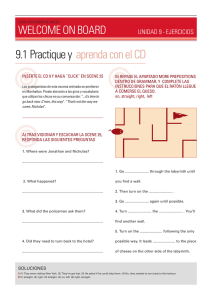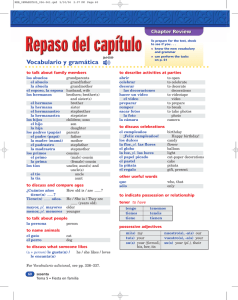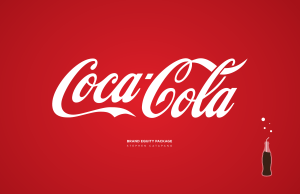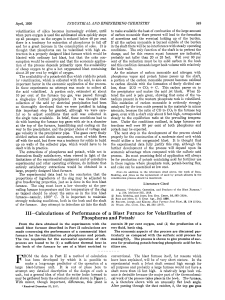The Advertising of Соса-Соla,Реклама Кока-Колы
Anuncio
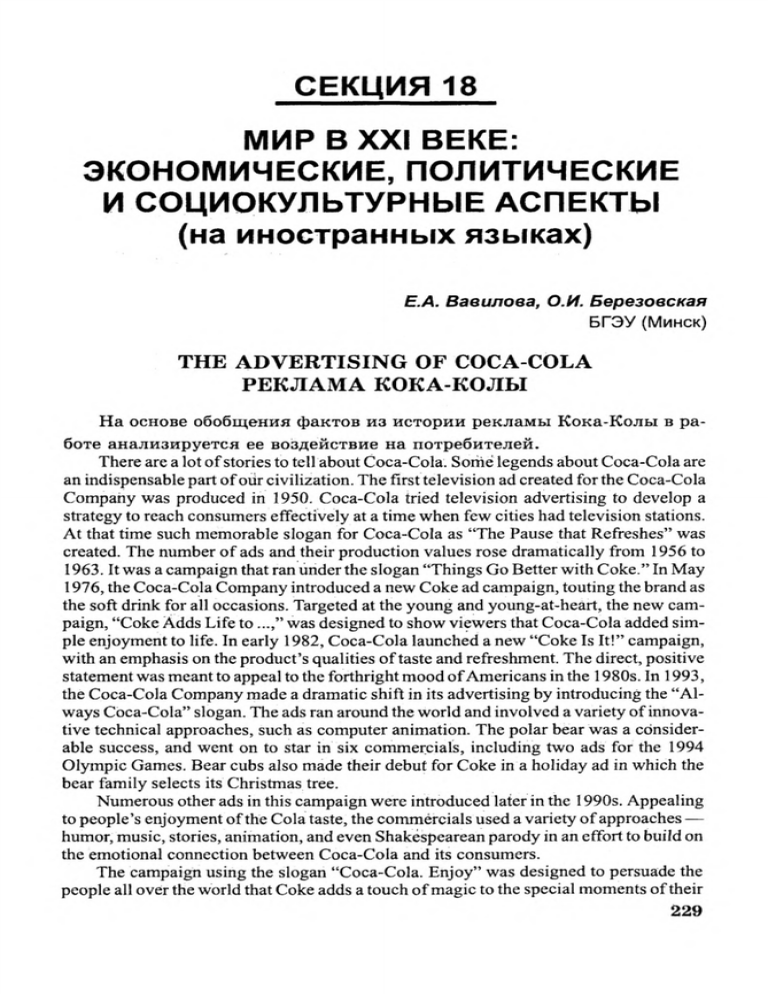
СЕКЦИЯ18 МИР В XXI ВЕКЕ: ЭКОНОМИЧЕСКИЕ, ПОЛИТИЧЕСКИЕ И СОЦИОКУЛЬТУРНЫЕ АСПЕКТЫ (на иностранных языках) Е.А. Вавилова, О.И. Березовская БГЭУ (Минск) ТНЕ ADVERTISING OF COCA-COLA РЕКЛАМА КОКА-КОЛЫ На основе обобщения фактов из истории рекламы Кока-Колы в ра­ боте анализируется ее воздействие на потребителей. There are а \ot of stories to tel\ about Соса-Со\а. Some legends about Coca-Cola are an indispensaЬ\e part of orir civilization. The first te\evision ad created for the Соса-Со\а Compahy was produced in 1950. Coca-Cola tried television advertising to develop а sti-ategy to reach consumers effectively at а time when few cities had te\evision stations. At that time such memoraЬ\e slogan for Соса-Со\а as "The Pause that Refreshes" was created. The number of ads and their production values rose dramatical\y from 1956 to 1963. Itwas а campaign that ran uriderthe slogan "Things Go Better with Coke." In Мау 1976, the Coca-Cola Company introduced а new Coke ad campaign, touting the brand as the soft drink for а\\ occasions. Targeted at the young and young-at-heart, the new campaign, "Coke Adds Life to """ was designed to show viewers that Соса-Со\а added simple enjoyment to life. In early 1982, Coca-Cola \aunched а new "Coke Is It!" campaign, with an emphasis оп the product's qualities oftaste and refreshment. The direct, positive statementwas meantto арреа\ to the forthright moodof Americans in the 1980s. In 1993, the Соса-Со\а Company made а dramatic shift in its advertising Ьу introducing the "Always Соса-Со\а" slogan. The ads ran around the world and invo\ved а variety of innovative technical approaches, such as computer animation. The polar bear was а ccinsideraЬ\e success, and went on to star in six commei:cials, including two ads for the 1994 Olympic Games. Bear cubs also made their debut for Coke in а holiday ad in which the bear family selects its Christmas tree. Numerous other ads in this campaign were introduced later' in the 1990s. Appealing to people's enjoyment ofthe Cola taste, the commercials used а variety of approaches humor, music, stories, aniination, and even Shakespearean parody in an effort to build on the emotional connection between Coca-Cola and its consumers. The campaign using the s\ogan "Coca-Cola. Enjoy" was designed to persuade the people all over the world that Coke adds а touch ofmagic to the special moments oftheir 229 lives. Stressing the fact that Coke is one of most common and affordaЬle pleasures oflife, the company conceived of the new slogan as an invitation to consumers to enjoy life's simple pleasшes with Coca-Cola. АЛ. Вашкевич БГЭУ (Минск) EL PROBLEMA DE LA ADOPCION INTERNACIONAL EN BIELORRUSIA ПРОБЛЕМА МЕЖДУНАРОДНОГО УСЫНОВЛЕНИЯ В БЕЛАРУСИ Одной из самых серьезных проблем XXI в. является торговля деть­ ми. В нашей стране одной из мер борьбы с этим преступлением является Закон Республики Беларусь "О международном усыновлении", кото­ рый регулирует выезд детей за границу и их усыновление иностранны­ ми гражданами. Сегодня в Беларуси - 29 тысяч сирот. У 90 % из них родители жи­ вы. Каждый год в республике усыновляется около тысячи детей, при­ мерно половина из них находит новую семью за рубежом. В среднем среди усыновляемых иностранцами детей около 85 % относятся к кате­ гории "очень больных". Таких детей могло бы быть гораздо больше, но белорусская сторона ограничивает количество заявок на усыновление от иностранных граждан. Для больных детей найти родителей в Бела­ руси сложно, так как на их лечение требуются немалые средства. Uno de los proЫemas del siglo XXI es el del secuestro у trafico de !а gente у de los niiios, en p articu laг. А реsаг de que по existen datos exactos sobre el traf)co infantil, se calcula que cada aiio 1,2 millones de niiios son victimas de multiples formas de trafico. Los Gobiemos de todos los paises tienen que demostrar un fuerte compromiso politico paia acabar con el trafico infantil. Se precisa la coordinaciбn de las acciones у !а aprobaciбn de acuerdos internacionales que se guien siempre рог el interes superior del вiiio. En Bielorrusia una de las medidas de !а lucha contra el trafico infantil es !а "Ley sobre la adopciбn internacional". Ноу en Bielorrusia hay 29 mil huerfanos. Anualmente el numero de los huerfanos Ьielorrusos se aumenta en 5 300 personas. Los niiios que provienen de orfanatos no todos son huerfanos, cerca del 90 % de ellos tienen padres. Cada aiio en Bielorrusia se adoptan cerca de mil niiios, aproximadamente la mitad de ellos encuentra uва familia nueva en el extranjero. Por termino medio, entre los adoptados por extгanjeros cerca del 85 % pe1·tenecen а la categoria "muy enferrno". Los prohijadores Ьielorrllsos estan orientados no simplemente а los niiios-huerfanos menores de edad, sino а los neonatos. Los niiios mayoгes de 1О aiios practicamente по tienen opoгtuпidad de encontrar familia entre los padres-compatriotas. Asimismo, es muy complicado encontrar padгes para los niiios que раdесеп de una enfeгmedad seria entre las familias Ьielorrusas porque para SLI tratamiento se necesitan unos medios bastante grandes. А pa11ir dcl 1 de noviembre de 2004 las autoridades Ьielorrusas restringieron fue1·temente las adopcioпes de los niiios рог extranjeros. Durante una reuniбn centrada en 230 Беларускі дзяржаўны эканамічны ўніверсітэт. Бібліятэка. Белорусский государственный экономический университет. Библиотека. Belarus State Economic University. Library. http://www.bseu.by
